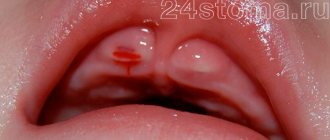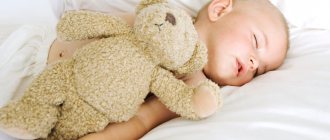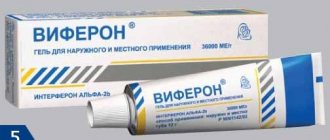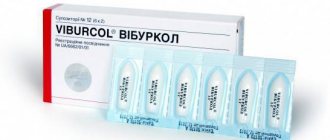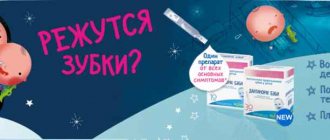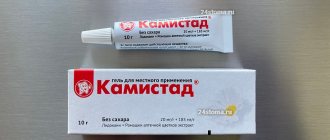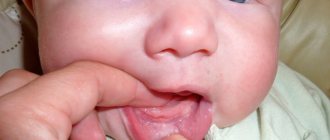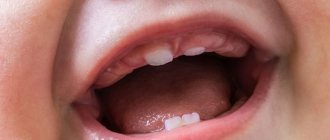“Viburkol” is a herbal preparation for relieving pain and inflammation when the first teeth appear
At the age of approximately 5-7 months, babies enter a difficult period - their first teeth begin to cut. For children, as well as for their parents, this stage turns into a serious test. And while some babies tolerate it more or less calmly, others experience obvious discomfort and severe pain, which they report by their whims, incessant crying and screams. During this period, the child may experience increased body temperature, cough, runny nose, and restless sleep. All this is a real stress not only for himself, but also for his worried mom and dad. In such cases, various pharmaceutical preparations and natural-based products come to the rescue, one of which is “Viburkol”, used for teething.
What is the drug "Viburkol"?
Viburkol is a suppository that has anti-inflammatory, soothing and antipyretic effects. They are mainly used by children, but sometimes pregnant women also take them.
The composition of one candle is as follows:
- pharmaceutical camomile;
- large plantain;
- belladonna or belladonna;
- meadow lumbago;
- bittersweet nightshade;
- calcium carbonate.
All of the above components are taken in homeopathic dilution, and inert pharmacologically solid fat is used as a basis. Since the fat base can melt at a temperature similar to body temperature, it is recommended to store the drug in the refrigerator or other place, and the air temperature should not exceed +25 ° C.
The homeopathic drug Viburkol helps ease teething in the baby
What happens in a baby's body when teeth begin to cut?
As mentioned above, the period of growth of the first milk teeth is associated with a certain stress for the child and is accompanied by some changes in his body. Obviously, there is a violation of the integrity of the gingival tissue, and this process, in turn, entails symptoms such as pain and burning in the area of eruption. Also, the child’s soft tissues of the oral cavity may become slightly red, and in some cases the cheeks may become slightly swollen. In addition, the body’s defenses are weakened, so many children simultaneously suffer from various infectious diseases.
Erupting the first teeth is a big challenge for a child.
And then the following happens: in order to minimize the risk of infection, the body begins to stimulate the production of saliva and interferon, which protects the child’s body and repels the attack of pathogenic bacteria1. This process is often accompanied by an increase in body temperature. Due to excessive salivation, slight irritation may appear on the chin and neck, and some disruptions in the functioning of the digestive system may occur - you should not be afraid of this, since all the child’s internal systems will normalize on their own as soon as teeth appear.
Experts do not recommend lowering the temperature during this period, but parents should still stock up on antipyretics in case of emergency. Currently, pharmacy shelves offer a wide range of drugs that help alleviate the baby’s condition during teething. According to reviews of Viburkol, this natural-based product really helps relieve severe inflammation and normalize the functioning of the digestive system.
Teething
A child's first teeth appear around 6–9 months of age in the first year of life. But the individual characteristics of the body can adjust this schedule, and milk teeth will break through the gums at an earlier period or will begin to bother the baby only closer to the age of one. Do not be alarmed by such changes; the delay in the appearance of teeth is not a pathology. The first tooth is considered the most painful and difficult, but it happens that its appearance may go unnoticed; parents will discover it only at the moment when it begins to knock on the spoon when feeding.
Fever
If the baby’s body temperature has risen, he behaves restlessly and the mother is sure that this is due to teething, then it is worth taking the following actions:
- to make sure there is a connection between tooth eruption and the painful condition, they invite a doctor who will accurately determine the cause of the ailment;
- stop worrying, gain patience and monitor the child’s condition; sometimes the temperature to 38º should not be reduced at all in order to give the body an excellent opportunity to fight the malaise on its own;
- when the temperature rises, the protective substance interferon begins to be produced in the body, and microbes and viruses lose their vital functions due to this, so it is better to be patient and not cool the body;
- since the child’s nervous system needs a night’s rest, the temperature should be lowered in the evening before bed;
- If, while monitoring the baby’s condition, the mother notices convulsions and spasms, then the high temperature should be brought down immediately, for this purpose viburkol is used.
Main causes of illness
The process of the appearance of the first and subsequent teeth is not an easy test for parents , since the baby behaves unusually restlessly, cries, often wakes up at night and reacts sharply to the uncomfortable condition of the gums:
- the whims of a small person are a sign of a very unusual condition for him, when a tooth cuts through the gum, and at the same time, strong heat, itching and unpleasant pain are felt at the site of the wound;
- the risk of infectious diseases and colds increases, since inflammatory processes in the oral cavity reduce the baby’s immunity;
- in the place where a wound appears on the gum, the body produces a large amount of saliva with bactericidal properties, which inhibits inflammation;
- bowel dysfunction, the appearance of dyspepsia may be associated with the penetration of infection through the oral cavity, where the child takes any objects that come across, fingers, in order to instinctively reduce pain symptoms and relieve itching;
- Itchy gums lead to loss of appetite; saliva produced irritates the skin of the cheek, neck and beard.
"Viburkol" - what kind of drug is it?
The drug in question belongs to the class of homeopathic remedies, produced by a German company. These are rectal suppositories, which are often used for young children during the eruption of their first milk teeth. However, this remedy helps relieve similar symptoms of many other childhood diseases.
According to experts in the field of pediatrics, this form of administration, namely suppositories, is the most preferable. This is a painless option for transferring medicinal substances into the body of a small child. Unlike tablets and capsules, suppositories do not provoke a gag reflex, and the active components of the drug are absorbed through the intestines much faster. In addition, “Viburkol” is a product created on the basis of plant components, so the harmful side effects are virtually reduced to zero.
Features of the drug use
Viburcol should be used in the evening, before bedtime or in the morning, until the child begins to be actively awake. This is explained by the fact that for the best absorption of the medicine from the intestines, the baby needs to be in a supine position for some time. If you don’t do this, some of the medicine liquefied by the heat will leak out.
Absorption of a substance in the intestine is always more effective than the action of the same component when it enters the stomach and then into the blood, therefore the effect manifests itself faster. Viburkol is often prescribed to children after one year, one suppository once or twice a day , since the painful condition is very individual and sometimes manifests itself at an older age.
Indications for use
According to the instructions for use, the drug "Viburkol" is effective in the following conditions:
- fevers of various etiologies,
- severe pain during the growth of the first teeth (recommended for children under 3 years of age),
- viral, fungal and bacterial infections,
- diseases of the genitourinary system,
- childhood dyspepsia - disruptions in the digestive tract, stomach pain, cramps and flatulence,
- mild disorders of the nervous system - anxiety syndrome, seizures and other symptoms.
Baby becomes restless when teething
What's included
The product in question contains only natural ingredients, and therefore has virtually no contraindications. Among the active ingredients of the drug:
- belladonna extract,
- pharmaceutical chamomile,
- bittersweet nightshade extract,
- plantain extract,
- calcium carbonate,
- meadow lumbago juice.
“When my son started teething, his temperature jumped, he had a runny nose - in short, the whole set. So, Viburkol helped us a lot. One candle was enough for the baby to fall asleep peacefully for the first time in a long time and not wake up all night! Therefore, I gave him this remedy for some time, and with it that terrible period passed easily and quickly. The temperature, however, was still there, but not as high as before using the suppositories.”
Alena D., Vladivostok, from correspondence on the women's forum
Chamomile, which is part of the drug, helps relieve inflammation.
Chamomile, which is part of the drug, helps relieve inflammation and reduce pain. Bittersweet nightshade fights infections in the body that cause fever. Belladonna also helps relieve inflammatory processes, but meadow lumbago is responsible for normalizing the functioning of the digestive and nervous systems. Plantain extract helps stop bleeding and reduce swelling.
How to give the drug to a child
Obviously, this herbal remedy really helps relieve acute symptoms, but how to give the drug to a child? Usually one candle 2-3 times a day is quite enough. In special situations, when the pain is too severe, more frequent use is allowed. In such cases, suppositories can be placed at intervals of half an hour, but the maximum duration of such intensive use of the drug is 2 hours.
It is recommended that a child under one year of age take half a candle twice a day. If a very young baby’s teeth begin to erupt, that is, in the first months of life, then in such situations experts allow the use of a quarter of a whole candle up to 4 times a day. It is better to discuss the exact dosage with your treating specialist.
On a note! How long does it take for Viburkol to work? As the active components of the drug are absorbed through the intestinal walls, they gradually reduce the temperature and pain. The sedative effect is usually observed half an hour after the introduction of the suppository, and the inflammation subsides only as a result of repeated use.
The use of the drug helps the child fall asleep peacefully
It is better to light a candle before bedtime - this way the child can get a good night’s sleep and rest. Keep in mind that when placing a suppository, there is still a risk of the drug leaking, especially if the child remains in an upright position. The product is also used for teething without fever, to relieve swelling, inflammation and pain.
Questions and answers - Temperature in a child
Izyakov Dmitry Nikolaevich
Pediatrician
April 25, 2021
In 2015, in the series of clinical recommendations of the Union of Pediatricians of Russia, the collection “Feverish Child” was published. Diagnostic and treatment protocols." It revises some points regarding the actions of doctors and parents when the temperature rises in children with various diseases. In this article, I tried to collect answers to the most frequently asked questions by parents, taking into account modern recommendations and practical experience.
What temperature is a reason to panic?
What you don't need is panic. According to modern data, only temperatures above 40 degrees can harm children with chronic diseases.
Initially healthy children tolerate high fever without health consequences. A healthy child is simply not able to heat himself up to dangerous levels. But it can be heated this way from the outside, by wrong actions. For example, with a normal fever, cover with a blanket when the air temperature in the room is above 22°C. But this is no longer a fever, but hyperthermia, a condition in which you need to call an ambulance. The main difference is that antipyretics and rubdowns do not help.
But does a high temperature indicate a dangerous disease?
In children, it is not the thermometer numbers that indicate danger. It is not the temperature that is dangerous, but the disease that caused it. A high temperature can also occur with an uncomplicated acute respiratory viral infection, which will subside in 2-3 days. Or in case of a safe childhood infection - sudden exanthema, also called: roseola, three-day fever, temperature is often 40-41°C. And with a dangerous disease, meningitis, it can often not exceed 39.5. There are also dangerous diseases accompanied by fever. This is what requires calling an ambulance:
- age up to 3 months
- the appearance, along with cold hands and feet, of a “marble” pattern on “goose bumps”
- absence of visible signs of illness, except for elevated temperature in a child under 3 years of age
- maintaining a temperature above 38.5 on the 4th day of illness with the appearance of rapid breathing
- skin rash that does not blanching when pressed with a finger
- inability to press the chin to the chest and/or bulging fontanelle
- abdominal pain
- pain in the legs and/or arms
- the temperature 2 hours after taking the antipyretic drug became higher, this is a sign of overheating - hyperthermia.
What about cramps?
They are observed in approximately four children out of a hundred and do not directly depend on the height of the temperature rise. In addition, they are not hazardous to health, although they undoubtedly frighten parents very much. Help for febrile seizures is to turn your head to the side and provide access to fresh air. All necessary medications are administered by an ambulance doctor, who must be called and met by another adult.
And is there really nothing dangerous about high temperatures?
Yes, this is dehydration - loss of fluid due to evaporation through breathing and sweat. When a child has a fever, it is difficult to persuade a child to drink, but it is at this moment that he needs it.
What about cold hands and feet?
Most often, this is a short-term phenomenon that does not require medical intervention and does not pose a threat to health.
How much do you need to lower the temperature?
1-1.5 degrees is enough, because only by raising the temperature does the child’s body fight infection.
At what thermometer readings should antipyretics be given?
I give general recommendations; you need to consult with the doctor who is treating your particular child.
- In children under 3 months of age - from 38°C
- In children older than 3 months who do not have chronic diseases - from 39°C
- In children with diseases of the brain, heart and lungs - from 38.5°C
Are these numbers the only basis?
No. The numbers on the thermometer do not matter when starting to take an antipyretic if the child:
- does not tolerate high temperatures very well, behaves restlessly
- has a “marbled” pattern on pale “goose bumps”
- trembles, he gets chills
What medications should I use?
Only based on ibuprofen and paracetamol, the names of the active substance are always indicated on the packaging under the antipyretic brand.
Why don't they help?
The most common reason is incorrect dosage, calculating the dose based on the child’s age and not on the weight of the child. The second common cause is dehydration. Third - the child is dressed too warmly, covered, the room is warm.
What dose should I give?
The most popular antipyretic based on ibuprofen is “Nurofen for children” in the form of syrup. You need to divide the child's weight in kilograms in half. For example, if the weight is 10 kg, then 10:2 = 5 ml of children's Nurofen and should be given to him. This dose can be repeated no earlier than 8 hours have passed.
The most successful antipyretic in terms of release form is “Efferalgan” syrup for children with the active ingredient paracetamol. Its measuring spoon allows you to take the dose of medicine directly by weight, without calculating it in mg.
All other drugs “Panadol”, “Calpol”, “Paracetamol” syrup, etc. require mathematical operations, multiplying the weight by 0.6. For example, if a child weighs 10 kg, then 10 * 0.6 = 6 ml of Panadol should be given. This dose can be repeated after 6 hours.
Is it possible to alternate them?
It is possible, but at least 2 hours should pass between taking paracetamol and ibuprofen. If taken together, there is a risk of kidney damage.
Why not other medications for fever?
Medical studies have not revealed any real benefits from other drugs, but they have identified the harm of each:
- “No-spa” has no effect on cold hands and feet, but it has a list of side effects.
- "Analgin" is dangerous for the development of loss of consciousness and should not be used by parents without the presence of ambulance and emergency services workers.
- Nise caused liver damage in one of the 250 patients who took it
- Aspirin can cause liver and brain damage in children
How much fluid do you need to drink to reduce your temperature?
For every kilogram of weight, a child needs to drink 4 ml per hour. That is, if a child weighs 10 kg, then every hour he should drink at least 10 * 4 = 40 ml.
Is it possible to wipe?
After taking an antipyretic, you can wipe with water at a temperature 1-2 degrees lower than the child’s body temperature. That is, if it is 40 °C, then the water temperature should be 38-39 °C. You need to wipe all areas of the skin that are hot to the touch, leaving them wet until dry. Then measure the temperature again. A decrease of 1-1.5 degrees is enough to stop the procedure.
What to do with cold hands and feet?
They need to be carefully warmed, gently rubbing until the skin becomes slightly red, using wool, a terry towel, or just your palms.
How long to expect the effect of antipyretic and rubdown?
Two hours. If the temperature has not decreased, then a second antipyretic should be given, and rubbing and drinking should continue for another 2 hours. If the temperature has not decreased and/or has increased, call an ambulance.
How can the ambulance help?
Assess the child’s condition and determine whether hospitalization is necessary in this case. Provide assistance by injecting medications and medical methods to reduce the child’s temperature. It is for fever, in fact, it is needed in a very small percentage of cases, the ineffectiveness of antipyretics associated with hyperthermia - a condition complicating fever, when the child is not able to give off body heat.
How to measure temperature correctly?
Measuring armpit temperature with a mercury glass thermometer in children has already been recognized as the least preferable due to the danger of breaking it. It was replaced by electronic and infrared thermometers. Few people know, but to obtain a result comparable to a mercury thermometer, the electronic one must be under the armpit for the same time. That is, 5 minutes if the child was at room temperature. And 10 minutes if it was at a lower temperature before measurement.
Why do electronic thermometers show lower temperatures?
The reasons are clear: loose pressure, measurement less than 5 minutes, sweat, spasm of skin blood vessels, low battery, lack of factory settings for measuring skin temperature. These thermometers can be used subject to correction. To do this, an adult without a fever puts an electronic one under one armpit and a mercury one under the other. Measures 5 minutes and compares. For example, we received 35.6 and 36.6, respectively. In subsequent electronic measurements you will add 1 degree.
Which thermometer is better?
The temple area has a temperature equal to the axillary one. To measure it, infrared thermometers are used. This is the most optimal method for parents today. For proper use, you need much fewer subtleties: wipe the sweat from your temple, remove your hair, hold it at the correct distance (indicated in the instructions), change the battery on time, set up to measure the temperature of the temporal region (also written in the instructions). The use of other thermometers: nipple, ear, forehead strips is fraught with measurement errors in the direction of underestimation or false increase.
How often should I measure my temperature?
A child with a fever needs temperature control:
- every 6 hours unless antipyretics are required
- every 4 hours when used effectively
- every 2 hours if use is ineffective.
For a child with normal temperature, but with an acute illness, measure every 12 hours in the evening. For a healthy child at risk of an acute illness due to contact or an increase in temperature for vaccination, according to the condition, for control, measure once a day, in the evening. Healthy children without risk of illness do not need it.
What else can you give your baby to expose his condition?
Currently, there is simply no complete analogue of the drug “Viburkol” with the same composition. However, there are plenty of products in pharmacies that doctors allow to be used to alleviate the condition of children as their baby teeth grow. Below are the most popular options:
- based on paracetamol: “Cefekon” and “Efferalgan” - help lower the temperature and reduce pain,
- based on ibuprofen: “Nurofen” and “Ibufen” - also help reduce temperature and block pain,
- gels with anesthetic: “Dentinox” and “Kamistad” - for application to the gums to reduce pain.
If the baby's temperature has risen sharply, not rectal suppositories, but antipyretic drugs in the form of syrups will be more effective. As for local pain relievers, due to the immediate action of lidocoin, they give the desired effect faster than others. If the symptoms are too severe and the temperature exceeds the permissible norms, the child should be immediately shown to a doctor. And remember: any medications, even those based on natural ingredients, should be given to the baby only with the permission of a specialist.
- Elizarova, V.M. Trend in changes in the timing of the eruption of primary teeth in the modern generation of children, 2002.
Instructions for using "Viburkol"
Viburkol suppositories are used rectally. If you look at the candle more closely, you can see that it is slightly pointed at one end, and at the opposite end it has a small funnel-shaped depression. This form makes it easier to administer the drug.
We place the pad of the index finger in the recess, and with the thumb and middle finger we cover the candle in both directions. Gently spread the child’s buttocks with the other hand and in one movement quickly insert the candle into the anus forward with the pointed end. The drug must enter completely.
Sometimes the baby's buttocks are squeezed a little so that he cannot push the drug out. If everything is done correctly, then the baby will not feel any discomfort from such a procedure.
